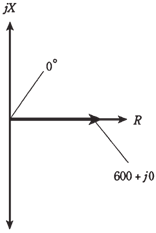Calculation of power factor:
There are two methods to determine the power factor in an alternating current circuit which contains reactance and resistance. Either way can be used in any situation, although at times one scheme is more convenient than other.
Cosine of phase angle
Recall that in the circuit having reactance and resistance, current and voltage are not in phase. The extent to which they differ in the phase is phase angle. If there is no reactance, then phase angle is 0°. If there is a pure reactance, then phase angle is either +90 °or -90 °.
The power factor is equal to cosine of phase angle. You can use the calculator to find this.
Problem:
A circuit has no reactance, but has a pure resistance of 600 Ω. What will be the power factor?
Without performing any calculations, it is evident that PF=1, as PVA = PT in the pure resistance. So PT/PVA = 1. But you can look at this by noticeing that the phase angle is 0°, as the current is in phase with the voltage. By using your calculator, find cos 0 = 1. Thus, PF = 1=100 %. The vector for this case is shown in the figure given below

Figure-- Phase angle for a pure resistance 600+j0.